Why Does A 35mm Camera Allow You To See The Image Correctly Oriented In The Viewfinder?
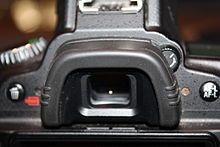
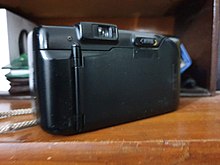
Viewfinder of a Nikon ZOOM 300 AF (35mm motion-picture show) photographic camera
In photography, a viewfinder is what the photographer looks through to compose, and, in many cases, to focus the picture. Near viewfinders are separate, and suffer parallax, while the single-lens reflex camera lets the viewfinder utilize the main optical organisation. Viewfinders are used in many cameras of different types: nonetheless and movie, film, analog and digital. A zoom camera unremarkably zooms its finder in sync with its lens, one exception being rangefinder cameras.
History [edit]
Before the development of microelectronics and electronic display devices, only optical viewfinders existed.
Directly optical viewfinders [edit]
Directly viewfinders are essentially miniature Galilean telescopes; the viewer'south eye was placed at the back, and the scene viewed through the viewfinder optics. A declining minority of point and shoot cameras use them. Parallax error results from the viewfinder being beginning from the lens axis, to point higher up and ordinarily to ane side of the lens. The mistake varies with distance, being negligible for distant scenes, and very large for close-ups. Viewfinders oftentimes prove lines to point the edge of the region which would be included in the photograph.
Some sophisticated 20th century cameras with direct viewfinders had coincidence (carve up-image) rangefinders, initially with separate windows from the viewfinder, later integrated with it; they were called rangefinder cameras. Cameras with interchangeable lenses had to betoken the field of view of each lens in the viewfinder; more usually, interchangeable viewfinders to match the lenses were used.
-

Leica IIIf viewfinder camera, 1951
-

German Tewe 35 mm to 200 mm zoom viewfinder
-
Early 21st century digicam with viewfinder
Waist-level (reflecting) viewfinders [edit]
Simple reflecting viewfinders, known too as "brilliant finders", comprised a small forward-looking lens, a small mirror at 45° backside it, and a lens at the top; the user held the camera at waist level and looked downwards into the lens, where a small image could be seen. Such viewfinders were integrated into box cameras, and fitted to the side of folding cameras. These viewfinders were fitted to inexpensive cameras.
-

Hasselblad
-

Kid's waist-view box photographic camera
-
Mamiya 645 1000s waist level finder
-
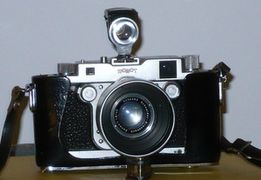
Robot Imperial Three camera with Zeiss Ikon waist level viewfinder attachment
Sportsfinder (sports viewfinder) [edit]
For many sports and printing applications optical viewfinders gave also small an image and were inconvenient to use for scenes that were changing chop-chop. For these purposes a simple arrangement of ii wire rectangles, a smaller ane nearer the eye and a larger one further away, was used, with no optics; the ii rectangles were aligned so the smaller one was centred in the larger, and the larger rectangle would give an indication of what would be included. This was fast and convenient to utilize, but not peculiarly accurate; cameras with sportsfinders ordinarily had optical viewfinders too.
A sportsfinder is sometimes known as an Albada finder. It is a "viewfinder used with a photographic camera held at heart level; the field of view is enclosed by a white frame that is made to announced very distant past reflection from the rear surface of the objective lens".[one]
Twin-lens reflex viewfinders [edit]

Twin-lens reflex (TLR) cameras had a large lens above the taking lens, and a big mirror at 45°, projecting an prototype onto a ground glass screen viewable from in a higher place, with the camera at waist level. The viewfinder lens was of like size and focal length to the taking lens, though the optical quality was less critical; the mirror was of similar size to the film. These cameras were relatively expensive; the Rolleiflex and cheaper sister Rolleicord were the pioneers. Both single- and twin-lens reflexes immune focussing by adjusting the lens until the image was precipitous.
Single-lens reflex viewfinders [edit]
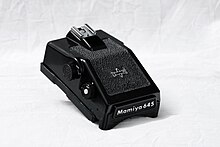
Mamiya 645 1000s AE finder
Single-lens reflex (SLR) cameras viewed the scene through the taking lens. Early SLRs were plate cameras, with a mechanism to insert a mirror between the lens and the moving picture which reflected the lite upwards, where information technology could be seen at waist level on a ground glass screen. When ready to take the moving picture, the mirror was pivoted out of the way (without moving the camera). Afterwards SLRs had a mechanism which flipped the mirror out of the mode when the shutter button was pressed, followed immediately by the shutter opening. Instead of a waist-level arrangement, a prism was used to let the photographic camera to be held to the center. The big advantage of the SLR was that whatsoever lens, or other optical device, could exist used; the viewfinder e'er showed exactly the epitome that would be projected onto the film. The live preview feature of digital cameras share this advantage of the SLR, as they also show the image exactly equally information technology volition be recorded, with no additional optics or parallax error.
Contemporary viewfinders [edit]
Viewfinders can be optical or electronic. An optical viewfinder is simply a reversed telescope mounted to see what the camera volition encounter. Its drawbacks are many, but information technology also has advantages; it consumes no power, information technology does not wash out in sunlight, and it has "full resolution" (i.due east. the resolution of the photographer'south eye). An electronic viewfinder (EVF) is a CRT, LCD or OLED based display device, though only the LCD is commonplace today due to size and weight. In addition to its main purpose, an electronic viewfinder can be used to replay previously captured cloth, and as an on-screen display to browse through menus.
A still camera'south optical viewfinder typically has one or more small-scale supplementary LED displays surrounding the view of the scene. On a film camera, these displays evidence shooting data such as the shutter speed and aperture and, for autofocus cameras, provide an indication that the epitome is correctly focussed. Digital still cameras will typically as well brandish information such as the electric current ISO setting and the number of remaining shots which can exist taken in a burst. Another brandish which overlays the view of the scene is often provided. It typically shows the location and land of the camera's provided automobile-focus points. This overlay can also provide lines or a filigree which assist in picture composition.
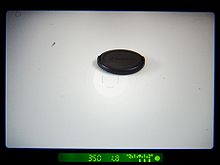
Typical film SLR viewfinder data

View through a Pentax K20D viewfinder (without lens)
Information technology is not uncommon for a photographic camera to have two viewfinders. For example, a digital still camera may have an optical viewfinder and an electronic one. The latter tin be used to replay previously captured material, has an on-screen display, and can exist switched off to save ability. A camcorder may have two viewfinders, both electronic. The commencement is viewed through a magnifying eyepiece, and due to a rubber eyepiece information technology can exist viewed perfectly even in vivid light. The second viewfinder would exist larger, of a college resolution, and may be mounted on the side of the camera. Because it consumes more power, a method is often provided to plow it off to save energy.
In belatedly 2010, Fujifilm appear hybrid viewfinder of optical viewfinder and electronic viewfinder in i viewfinder for its highend meaty cameras. There is a one-half mirror prism that reflect data from LCD to the optical viewfinder, then nosotros can run into both the shooting frame and the shooting data. A button tin can change the hybrid function to electronical viewfinder past blocking the paradigm through the optical viewfinder with moving a half mirror prism to be a straight up mirror.[2]
Some special purpose cameras do not accept viewfinders at all. These are, for instance, web cameras and video surveillance cameras. They utilise external monitors as their viewfinders.
See also [edit]
- Director's viewfinder
- Electronic viewfinder
- Eyepiece
- Finderscope
- Live preview
- Waist-level finder
References [edit]
- ^ "Answers - The Most Trusted Place for Answering Life'southward Questions". Answers.com . Retrieved 2018-08-09 .
- ^ "Fujifilm explains how its X100 hybrid viewfinder works, nosotros nod and pretend to understand". Retrieved Nov two, 2013.
Source: https://en.wikipedia.org/wiki/Viewfinder
Posted by: cooktheartumety.blogspot.com

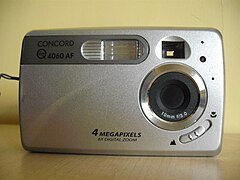


0 Response to "Why Does A 35mm Camera Allow You To See The Image Correctly Oriented In The Viewfinder?"
Post a Comment